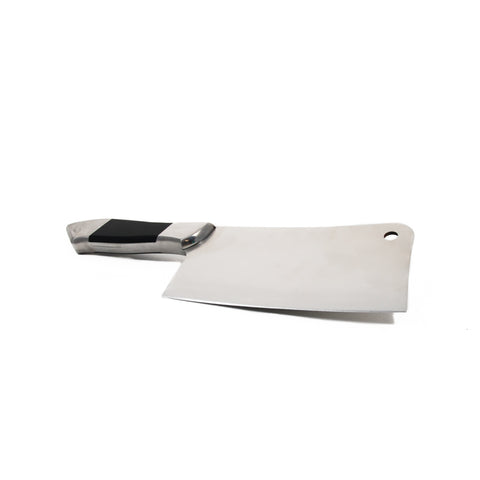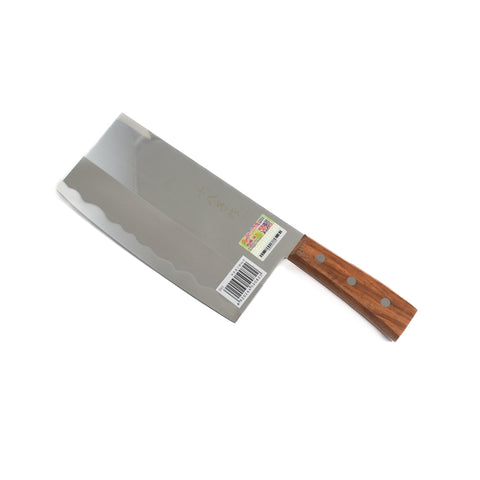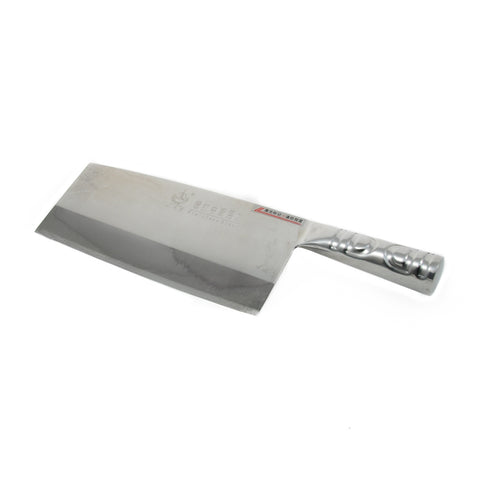Buyer’s Guide to Chinese Cleavers or Choppers
by Kristin Lohse

Are you looking to buy a Chinese cleaver or Chinese chopper knife? In this guide, we take you through the considerations before you buy. Plus different ways to use a Chinese cleaver.
Sous Chef knife experts
In this guide, you’ll hear from Sous Chef buyer Kristin Lohse, who has many years of kitchen knife experience - and is a true expert in sharpening and caring for knives.
In his blog, we’ll discuss:
- What cleaver knives are used for
- What to consider before you buy a Chinese cleaver
- How cleaver knives differ
Read our ultimate guide to which kitchen knives you need - to understand more about the role of a Chinese cleaver and a Chinese chopper knife.
What is the difference between a “cleaver” and a “chopper”
Chinese choppers and cleavers both have a distinctive large blade. But they are used very differently. A cleaver can be used on bones. But a chopper is more delicate, and is used for preparing meat and vegetables - but not for heavy-duty tasks.
A ‘cleaver’ is typically used for heavy-duty tasks like chopping through bones, with a thick, heavy blade that delivers powerful chops. It's designed to handle tough materials without damaging the blade.
In contrast, a chopper has a thinner, lighter blade, intended for a broader range of kitchen tasks beyond just chopping. It's used for slicing, dicing, and mincing vegetables, meats, and fish with precision.
How do you use a Chinese chopper?
Using a Chinese chopper involves mastering a few techniques for versatility.
- For chopping and dicing, use the blade's middle section, applying even pressure for uniform cuts.
- For finer tasks like mincing garlic or herbs, use the blade's front part, rocking it back and forth over the ingredients.
- Slice meats and vegetables by using a fluid, gliding motion, allowing the sharp edge to do the work with minimal force.
- When handling a Chinese chopper, maintain a firm grip on the handle, keeping your fingers tucked safely away.
How do you slice vegetables with a Chinese chopper?
- For slicing, hold the chopper with a firm grip, and slice using a swift, downward motion without much force.
- For dicing, slice the vegetable into flat pieces, then stack or line them up to cut into strips before dicing into smaller pieces.
- Use the chopper’s wide blade to scoop up and transfer the cut vegetables. Keep your fingers curled inward to avoid accidents, and use the knuckle of your guiding hand as a guide against the side of the blade.
How do you sharpen a Chinese chopper?
Just with any knife, a Chinese chopper requires regular maintenance. Use a honing rod weekly to realign the edge, ensuring it remains straight and true. For sharpening, a whetstone is ideal.
- Start with a coarse grit to grind any nicks or unevenness, then move to a finer grit for a razor-sharp finish.
- Soak the stone in water before use to reduce friction and prevent damage to the blade.
- Hold the chopper at a consistent angle, typically around 15-20 degrees, and slide it across the stone in smooth, even strokes, covering the entire length of the blade.
- Repeat on both sides until sharp.
- Wash and dry the chopper after sharpening to remove any metal filings.
With proper care, your Chinese chopper will maintain its sharpness, making kitchen prep work easier and more efficient.
How thick should a Chinese chopper be?
The ideal thickness of a Chinese chopper varies, depending on its use. For general kitchen tasks like slicing vegetables and cutting meat, a blade thickness of about 2 to 3 millimetres is common.
This provides a good balance between sharpness and strength, allowing for precise cuts without the blade being too heavy or unwieldy. Choppers designed for more delicate work, such as finely chopping herbs or vegetables, might be slightly thinner to enhance precision.
Conversely, cleavers meant for tougher tasks, though not typically used for chopping bones, may be slightly thicker for added durability.
Why is there often a hole in a Chinese cleaver?
The hole in a Chinese cleaver serves a practical purpose. It allows the knife to be hung up, so it's readily accessible in the busy environment of a kitchen. Cleavers are often too large for conventional knife blocks. And take up a lot of space on a knife rack. So hanging by a hook is a practical way to conserve kitchen space.
What is the difference between a Chinese chopper and a Chinese cleaver?
The terms "Chinese chopper" and "cleaver" often cause confusion, because of their similar shape. But a chopper is for everyday kitchen tasks, such as slicing meat and vegetables. And a cleaver is more weighty, and can be used to slice through bones.
Main difference is price point, look and one of them has a hole.
Which Chinese cleaver knife should I buy?
This Chinese meat cleaver is designed for chopping through bone – perfect for jointing chicken and cutting up red meat. The Chinese meat cleaver is a beautifully-balanced knife, with a stout, heavy blade that’s ideal for getting weight behind it. It is also great for cutting through fruit and vegetables like squash and pineapple.
This Chinese cleaver is a versatile tool for chopping, slicing and preparing meat. The heavy steel blade is perfect for jointing a chicken.
The tall, rectangular blade easily cuts through joints of meat and whole fish. It can also handle large fruits and vegetables like melon, cabbage and squash.
The sturdy wooden handle gives you superior cutting control. The blade effortlessly cuts through hard bones like pork ribs but can also be used to chop and dice vegetables.
Use the flat side of the blade to crush ingredients like garlic and lemongrass. It’s great for scraping food off your chopping board and into your wok or pan.
For chopper
This stainless steel chopper, or Chinese chopper, is a versatile piece of kit perfect for cutting meat and vegetables. The large, rectangular blade has a similar use to a Santoku knife, and is a great everyday knife for preparing meat and vegetable stir fries.
This stainless steel chopper should not be confused with a European cleaver which is heavier and traditionally used for cutting bones.

About the author
Kristin is the Purchasing and Buying assistant at Sous Chef. She has several chefs and excellent home cooks in her family, and grew up in the kitchen in Sweden. Cooking and baking with her mum happened pretty much every day. Cinnamon rolls were always stocked up in the freezer, and if they were running low, more baking had to be done. Kristin always loves learning more about food and ingredients to continue improving her skills.





